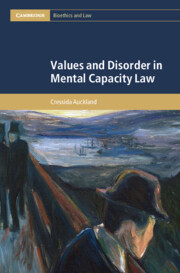Refine search
Actions for selected content:
105 results
Initial effects of Mental Health First Aid training on mental health literacy, social distance, stigma, mental health, and quality of life in the German adult population – Findings from a pilot study
-
- Journal:
- European Psychiatry / Volume 68 / Issue 1 / 2025
- Published online by Cambridge University Press:
- 27 October 2025, e164
-
- Article
-
- You have access
- Open access
- HTML
- Export citation
Offending and psychiatric disorders from age 20 to 63 among individuals with and without past experience of out-of-home care in Sweden: A prospective multi-trajectory cohort study
-
- Journal:
- Development and Psychopathology , First View
- Published online by Cambridge University Press:
- 10 September 2025, pp. 1-15
-
- Article
-
- You have access
- Open access
- HTML
- Export citation
Diagnostic trajectories and stability of mental disorders in childhood and adolescence – A nation-wide cohort study using sequence analysis
-
- Journal:
- European Psychiatry / Volume 68 / Issue 1 / 2025
- Published online by Cambridge University Press:
- 26 August 2025, e126
-
- Article
-
- You have access
- Open access
- HTML
- Export citation
6 - Diminished Responsibility
- from Part III - Partial Excuse (Practice, Doctrine, and Theory)
-
- Book:
- The Boundaries of Blame
- Published online:
- 26 July 2025
- Print publication:
- 14 August 2025, pp 181-215
-
- Chapter
- Export citation
4 - Legal Insanity and Related Doctrines
- from Part I - Criminal Law
-
-
- Book:
- Core Concepts in Criminal Law and Criminal Justice
- Published online:
- 09 July 2025
- Print publication:
- 24 July 2025, pp 96-137
-
- Chapter
- Export citation
10 - What Does Personality Have to Do with Mental Disorder?
- from Part III - Novel Conceptual Approaches to Personality Disorder
-
-
- Book:
- Conceptualizing Personality Disorder
- Published online:
- 25 June 2025
- Print publication:
- 10 July 2025, pp 181-195
-
- Chapter
- Export citation
Chapter 1 - The Origins of Psychiatry as a Profession
- from Part I - The Origins of the Profession and Its Different Perspectives
-
-
- Book:
- Values in Psychiatry
- Published online:
- 24 June 2025
- Print publication:
- 10 July 2025, pp 5-17
-
- Chapter
- Export citation
Psychopathology in Dutch women with terrorist behaviours: empirical case series study
-
- Journal:
- BJPsych Open / Volume 11 / Issue 3 / May 2025
- Published online by Cambridge University Press:
- 16 April 2025, e87
-
- Article
-
- You have access
- Open access
- HTML
- Export citation
A systematic review of studies using network analysis to assess dynamics of psychotic-like experiences in community samples
-
- Journal:
- Psychological Medicine / Volume 55 / 2025
- Published online by Cambridge University Press:
- 19 February 2025, e54
-
- Article
-
- You have access
- Open access
- HTML
- Export citation
Adult psychiatric outcomes of young people who attended child and adolescent mental health services: a longitudinal total population study
-
- Journal:
- Psychological Medicine / Volume 55 / 2025
- Published online by Cambridge University Press:
- 10 February 2025, e34
-
- Article
-
- You have access
- Open access
- HTML
- Export citation
The role of olive oil and its constituents in mental health: a scoping review
-
- Journal:
- British Journal of Nutrition , First View
- Published online by Cambridge University Press:
- 19 December 2024, pp. 1-11
-
- Article
- Export citation
Suicidal behavior in patients with severe mental disorders prior to and during the COVID-19 pandemic
-
- Journal:
- Psychological Medicine / Volume 54 / Issue 16 / December 2024
- Published online by Cambridge University Press:
- 16 December 2024, pp. 4759-4767
-
- Article
-
- You have access
- Open access
- HTML
- Export citation

Values and Disorder in Mental Capacity Law
-
- Published online:
- 25 October 2024
- Print publication:
- 27 June 2024
Racial disparities influence access and outcomes in talking therapies
-
- Journal:
- The British Journal of Psychiatry / Volume 226 / Issue 4 / April 2025
- Published online by Cambridge University Press:
- 30 September 2024, pp. 203-205
- Print publication:
- April 2025
-
- Article
-
- You have access
- HTML
- Export citation
Introduction
-
- Book:
- Values and Disorder in Mental Capacity Law
- Published online:
- 25 October 2024
- Print publication:
- 27 June 2024, pp 1-15
-
- Chapter
- Export citation
3 - Why Disorder Matters
-
- Book:
- Values and Disorder in Mental Capacity Law
- Published online:
- 25 October 2024
- Print publication:
- 27 June 2024, pp 88-140
-
- Chapter
- Export citation
2 - An Essential Role for Values in Assessments of Capacity
-
- Book:
- Values and Disorder in Mental Capacity Law
- Published online:
- 25 October 2024
- Print publication:
- 27 June 2024, pp 37-87
-
- Chapter
- Export citation
Chapter 2 - Violence and Mental Disorder
-
-
- Book:
- Seminars in Forensic Psychiatry
- Published online:
- 06 June 2024
- Print publication:
- 13 June 2024, pp 36-64
-
- Chapter
- Export citation
Chapter Two - Nonhuman Behavioral Methods
-
- Book:
- Understanding Figures in Neuroscience Research
- Published online:
- 22 November 2024
- Print publication:
- 13 June 2024, pp 26-82
-
- Chapter
- Export citation
Chapter 4 - Prison Psychiatry
-
-
- Book:
- Seminars in Forensic Psychiatry
- Published online:
- 06 June 2024
- Print publication:
- 13 June 2024, pp 92-118
-
- Chapter
- Export citation
